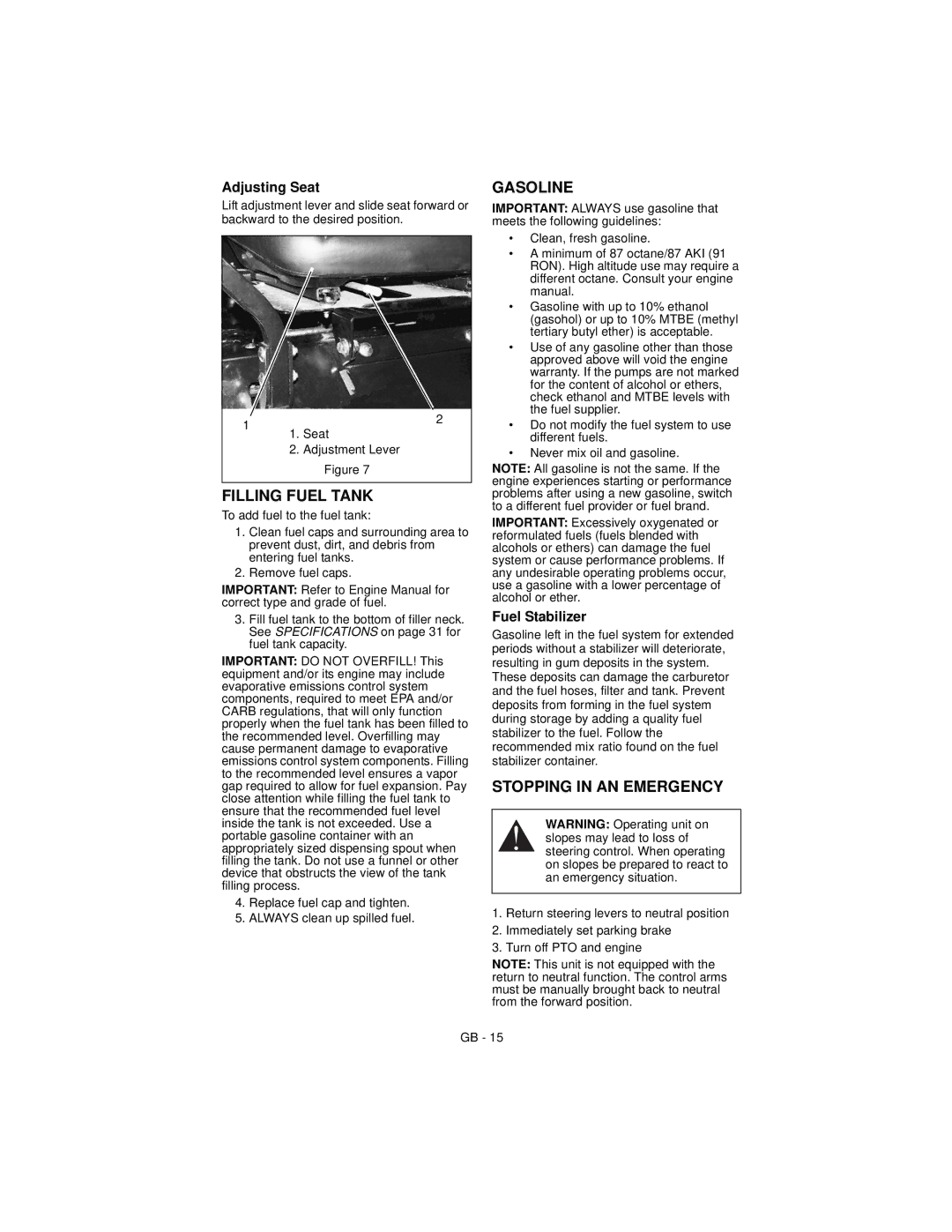
Adjusting Seat
Lift adjustment lever and slide seat forward or backward to the desired position.
1 |
| 2 | |
1. | Seat | ||
| |||
| 2. | Adjustment Lever |
Figure 7
FILLING FUEL TANK
To add fuel to the fuel tank:
1.Clean fuel caps and surrounding area to prevent dust, dirt, and debris from entering fuel tanks.
2.Remove fuel caps.
IMPORTANT: Refer to Engine Manual for correct type and grade of fuel.
3.Fill fuel tank to the bottom of filler neck. See SPECIFICATIONS on page 31 for fuel tank capacity.
IMPORTANT: DO NOT OVERFILL! This equipment and/or its engine may include evaporative emissions control system components, required to meet EPA and/or CARB regulations, that will only function properly when the fuel tank has been filled to the recommended level. Overfilling may cause permanent damage to evaporative emissions control system components. Filling to the recommended level ensures a vapor gap required to allow for fuel expansion. Pay close attention while filling the fuel tank to ensure that the recommended fuel level inside the tank is not exceeded. Use a portable gasoline container with an appropriately sized dispensing spout when filling the tank. Do not use a funnel or other device that obstructs the view of the tank filling process.
4.Replace fuel cap and tighten.
5.ALWAYS clean up spilled fuel.
GASOLINE
IMPORTANT: ALWAYS use gasoline that meets the following guidelines:
•Clean, fresh gasoline.
•A minimum of 87 octane/87 AKI (91 RON). High altitude use may require a different octane. Consult your engine manual.
•Gasoline with up to 10% ethanol (gasohol) or up to 10% MTBE (methyl tertiary butyl ether) is acceptable.
•Use of any gasoline other than those approved above will void the engine warranty. If the pumps are not marked for the content of alcohol or ethers, check ethanol and MTBE levels with the fuel supplier.
•Do not modify the fuel system to use different fuels.
•Never mix oil and gasoline.
NOTE: All gasoline is not the same. If the engine experiences starting or performance problems after using a new gasoline, switch to a different fuel provider or fuel brand.
IMPORTANT: Excessively oxygenated or reformulated fuels (fuels blended with alcohols or ethers) can damage the fuel system or cause performance problems. If any undesirable operating problems occur, use a gasoline with a lower percentage of alcohol or ether.
Fuel Stabilizer
Gasoline left in the fuel system for extended periods without a stabilizer will deteriorate, resulting in gum deposits in the system. These deposits can damage the carburetor and the fuel hoses, filter and tank. Prevent deposits from forming in the fuel system during storage by adding a quality fuel stabilizer to the fuel. Follow the recommended mix ratio found on the fuel stabilizer container.
STOPPING IN AN EMERGENCY
WARNING: Operating unit on slopes may lead to loss of steering control. When operating on slopes be prepared to react to an emergency situation.
1.Return steering levers to neutral position
2.Immediately set parking brake
3.Turn off PTO and engine
NOTE: This unit is not equipped with the return to neutral function. The control arms must be manually brought back to neutral from the forward position.
GB - 15
